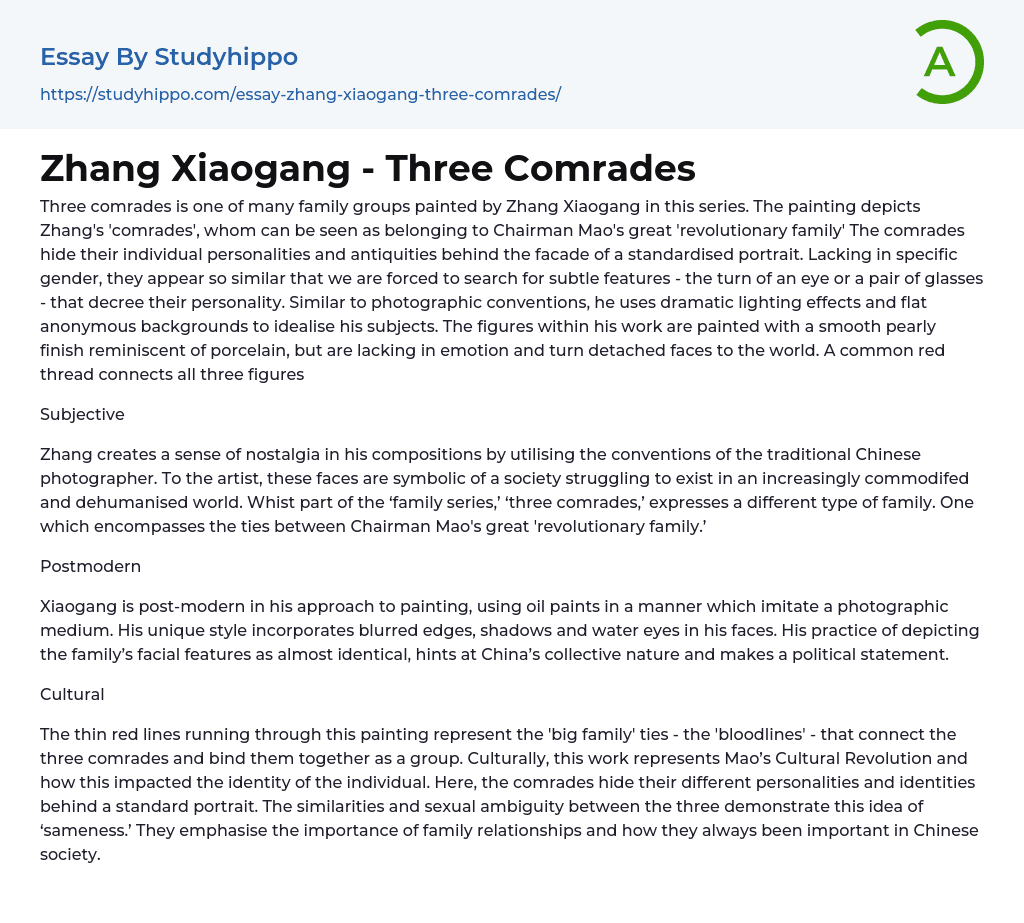Three comrades is one of many family groups painted by Zhang Xiaogang in this series. The painting depicts Zhang's 'comrades', whom can be seen as belonging to Chairman Mao's great 'revolutionary family' The comrades hide their individual personalities and antiquities behind the facade of a standardised portrait. Lacking in specific gender, they appear so similar that we are forced to search for subtle features - the turn of an eye or a pair of glasses - that decree their personality. Similar to photographic conventions, he uses dramatic lighting effects and flat anonymous backgrounds to idealise his subjects. The figures within his work are painted with a smooth pearly finish reminiscent of porcelain, but are lacking in emotion and turn detached faces to the world. A common red thread connects all three figures
Subjective
Zhang creates a sense of nostalgia in his compositions
...by utilising the conventions of the traditional Chinese photographer. To the artist, these faces are symbolic of a society struggling to exist in an increasingly commodifed and dehumanised world. Whist part of the ‘family series,’ ‘three comrades,’ expresses a different type of family. One which encompasses the ties between Chairman Mao's great 'revolutionary family.’
Postmodern
Xiaogang is post-modern in his approach to painting, using oil paints in a manner which imitate a photographic medium. His unique style incorporates blurred edges, shadows and water eyes in his faces. His practice of depicting the family’s facial features as almost identical, hints at China’s collective nature and makes a political statement.
Cultural
The thin red lines running through this painting represent the 'big family' ties - the 'bloodlines'
- that connect the three comrades and bind them together as a group. Culturally, this work represents Mao’s Cultural Revolution and how this impacted the identity of the individual. Here, the comrades hide their different personalities and identities behind a standard portrait. The similarities and sexual ambiguity between the three demonstrate this idea of ‘sameness.’ They emphasise the importance of family relationships and how they always been important in Chinese society.
- Business Law essays
- Contract essays
- Consumer Protection essays
- Property essays
- Ownership essays
- Agreement essays
- Common Law essays
- Contract Law essays
- Justice essays
- Security essays
- Tort Law essays
- United States Constitution essays
- Crime essays
- Lawsuit essays
- Treaty essays
- Family Law essays
- Marijuana Legalization essays
- Constitution essays
- War on Drugs essays
- Court essays
- Jury essays
- Police essays
- Protection essays
- Community Policing essays
- Criminal Law essays
- Judge essays
- Lawyer essays
- Employment Law essays
- Copyright Infringement essays
- Injustice essays
- Intellectual Property essays
- Breach Of Contract essays
- Jurisprudence essays
- Social Injustice essays
- Juvenile Justice essays
- Internet Privacy essays
- Cyber Security essays
- Bill Of Rights essays
- Civil Liberties essays
- First Amendment To The United States Constitution essays
- Fourth Amendment To The United States Constitution essays
- Second amendment essays
- Animal Cruelty essays
- Law Enforcement essays
- Juvenile Justice System essays
- Surveillance essays
- Forensic Science essays
- Crime Prevention essays
- Criminal Justice essays
- Criminology essays




